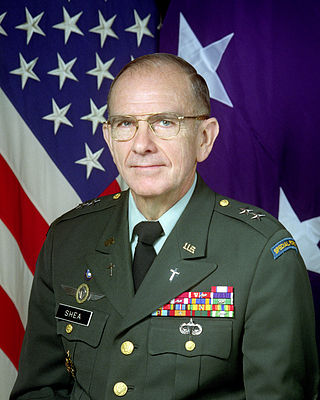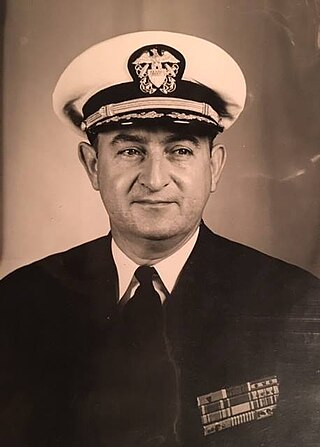
The Archdiocese for the Military Services, U.S.A., officially the Military Ordinariate of United States of America, is a Latin Church jurisdiction of the Catholic Church for men and women serving in the United States Armed Forces and their dependents.

A military chaplain ministers to military personnel and, in most cases, their families and civilians working for the military. In some cases, they will also work with local civilians within a military area of operations.

Edwin Frederick O'Brien is an American prelate of the Catholic Church. He has been a cardinal since 2012 and headed the Order of the Holy Sepulchre from 2011 to 2019.

The Saint Paul Seminary (SPS) is a Catholic major seminary in St. Paul, Minnesota. A part of the Archdiocese of Saint Paul and Minneapolis, SPS prepares men to enter the priesthood and permanent diaconate, and educates lay men and women on Catholic theology.

The United States Army Chaplain Corps (USACC) consists of ordained clergy of multiple faiths who are commissioned Army officers serving as military chaplains as well as enlisted soldiers who serve as assistants. Their purpose is to offer religious church services, counseling, and moral support to the armed forces, whether in peacetime or at war.

John Joseph Mitty was an American prelate of the Roman Catholic Church. He served as the third Bishop of Salt Lake City (1926–1932) and the fourth Archbishop of San Francisco (1935–1961).

St. Robert Bellarmine Catholic Church is a Catholic parish on North Fifth Street in Burbank, California. It includes a Catholic church, elementary school, and high school. Founded in 1907, it was one of the first Catholic churches in the San Fernando Valley. Known as Holy Trinity Parish until 1939, it was renamed in honor of St. Robert Bellarmine. The church and school buildings on the St. Robert Bellarmine campus are modeled after colonial American buildings, including Monticello, Independence Hall, Mount Vernon and the library at the University of Virginia.

St. Andrew's Catholic Church is a Catholic church in Pasadena, California. Founded in 1886, it is the oldest Catholic parish in Pasadena and one of the oldest in Los Angeles County. Its Romanesque Revival campanile bell tower is visible for miles and is one of the landmarks of Pasadena. The interior of the current church, built in 1927, was modeled after the Basilica of Santa Sabina in Rome, while the façade was modeled after the church of Santa Maria in Cosmedin, down the hill and slightly upriver from Santa Sabina.

Emil Joseph Kapaun was a Roman Catholic priest and United States Army captain who served as a United States Army chaplain during World War II and the Korean War. Kapaun was a chaplain in the Burma Theater of World War II, then served again as a chaplain with the U.S. Army in Korea, where he was captured. He died in a prisoner of war camp.
Charles John Klyberg was a British Roman Catholic priest and former Anglican bishop. From 1985 to 1996, he was the Bishop of Fulham in the Church of England.

Luis Rafael Zarama Pasqualetto is a Colombian-born American prelate of the Roman Catholic Church who has been serving as the bishop of the Diocese of Raleigh in North Carolina since 2017. He previously served as an auxiliary bishop of the Archdiocese of Atlanta from 2009 to 2017
Henry Timothy Vakoc ("VAH-kitch") was a Roman Catholic priest and a United States Army chaplain during the Iraq War, attaining the rank of major. He was critically injured on May 29, 2004, when his Humvee was struck by an IED as he was returning from celebrating Mass for soldiers. He was also the first documented U.S. Army chaplain seriously injured during Operation Iraqi Freedom. He died on June 20, 2009.

The Catholic Diocese of the Australian Military Services, is a military ordinariate of the Roman Catholic Church immediately subject to the Holy See. It was established in 1969 and maintains its Chancery office in Canberra. It is a Diocese in its own right and not governed under any Diocese or Archdiocese.

Thomas John McDonnell, D.D., was an American prelate of the Roman Catholic Church who served as the coadjutor bishop of the Diocese of Wheeling in West Virginia.

William Richard Arnold was an American Army officer and bishop of the Roman Catholic Church. He served as the 5th Chief of Chaplains of the United States Army from 1937 to 1945 and Military Delegate of the Armed Forces from 1945 until his death in 1965.

Francis Leon Sampson was a Catholic priest and American Army officer who served as the 12th Chief of Chaplains of the United States Army from 1967 to 1971. A World War II paratrooper chaplain who participated in the D-Day landings and the Battle of the Bulge, Sampson was captured during both engagements and spent time in prisoner-of-war camps. He also served in the Korean War. A decorated war hero, he received the Bronze Star, Purple Heart, and Distinguished Service Cross and was nominated for the Medal of Honor.

Donald William Shea was an American Army officer and Catholic priest who served as the 19th Chief of Chaplains of the United States Army from 1994 to 1999.

Patrick John Hessian was an American major general and Catholic priest who served as the 16th Chief of Chaplains of the United States Army from 1982 to 1986.

Rt. Rev. Msgr. James Hugh O'Neill was an American Catholic priest who served as a chaplain in the United States Army from 1926 to 1952, rising to the rank of brigadier general. While serving as chaplain of the Third United States Army during the Battle of the Bulge in World War II, he composed the famous "Weather Prayer" at the request of the Third Army's commander, General George S. Patton.

Francis William Kelly was an American Catholic priest who served as a chaplain during World War II, embedded in the Pacific Theater with the U.S. Marines. Kelly was present at Guadalcanal, Tarawa, Okinawa and Iwo Jima; his presence on front lines earned him his nicknames, including "Father Foxhole" and "Foxhole Kelly". He was featured in the wartime book Guadalcanal Diary and a fictionalized version of him appeared in the subsequent film. After a brief period in parochial assignments after World War II ended, he re-entered active duty during the Korean War and remained as an active chaplain until his retirement in 1969.



























